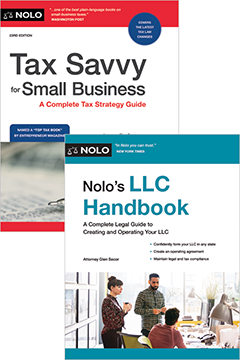Owners of a single-member LLC are not employees and instead must pay self-employment tax on their earnings.
As the owner of a single-member limited liability company (SMLLC) (with the default tax classification of disregarded entity), you are not considered an employee and income you receive from your company is not considered a salary. Instead, just like a sole proprietor, the IRS considers you to be self-employed, and the income you receive is considered earnings from self-employment. As such, income you receive from your SMLLC is subject to federal self-employment tax.
Self-employment tax is separate from, and in addition to, the tax you pay on your gross income. The federal government taxes most, but not quite all, of a person's income from self-employment. (To be precise, the tax applies to 92.35% of your net earnings from self-employment.) Self-employment income up to an annual specified threshold amount is taxed at a rate of 15.3%. This is comprised of a 12.4% tax for Social Security and a 2.9% tax for Medicare. For earnings from self-employment above the annual ceiling amount, only the 2.9% Medicare tax applies. There is an additional 0.9% Medicare tax that applies for taxpayers whose income exceeds $250,000 if married and filing jointly, or $200,000 if single. For these taxpayers, the effective Medicare tax rate is 3.8%--the standard 2.9% rate plus an extra 0.9%. As a (perhaps minor) consolation, you can deduct half of the amount of your self-employment tax as a business expense, which lowers your overall federal tax bill.
When it's time to file your annual federal tax return, you'll need to include Schedule SE, Self-Employment Tax, with your Form 1040. Schedule SE is the IRS form used to compute and report the amount of your self-employment tax obligation. Some of the information on Schedule SE comes from Schedule C so you'll want to have your Schedule C handy when you work on Schedule SE. Also, keep in mind that if your earnings from self-employment are less than a specified amount and you meet a few other conditions, you can use the short form of Schedule SE.
EXAMPLE: After ten years working as an electrical engineer for a large corporation, Tessa starts a part-time business as an engineering consultant to small tech start-ups. She creates an SMLLC and, in its first year, Tessa's new business earns a $20,000 net profit. When Tessa files her taxes, she includes Schedule SE, which shows $20,000 of self-employment income from her SMLLC. (Under IRS rules, Tessa is required to pay tax on the entire amount of her SMLLC's profit.) She pays 15.3% self-employment tax on that amount ($3,060). She also gets to deduct half the self-employment taxes she paid ($1,530) as a business expense on her Form 1040 which reduces the adjusted gross income she reports for the year (and therefore lowers her overall taxes).
Unless an SMLLC is reclassified as a corporation for tax purposes, it's generally not possible for the owner of an SMLLC to avoid the requirement to pay self-employment taxes. By contrast, under certain conditions, individual members of some multi-member LLCs can avoid self-employment taxes without re-classification. If reducing or avoiding self-employment taxes is extremely important to you, you may want to check into converting your SMLLC to a multi-member LLC with passive members or a non-member manager. You can also check our article on re-classifying your company as an S corporation.
One other point to keep in mind: You don't pay self-employment tax on passive income. The IRS defines just two types of passive activity:
- trade or business activities in which you do not materially participate during the year; and
- rental activities, even if you materially participate in them, unless you are a real estate professional.
It would be highly unusual for a person to meet the first definition: Own an SMLLC engaged in trade or business yet not materially participate in those activities.
The second type of passive activity defined by the IRS, however, is often relevant. Many people use SMLLCs in connection with rental property they own. If you've set up an SMLLC for this purpose, you won't need to pay self-employment tax on your rental income. You will, however, need to report any income (or loss) from your rental property using IRS Schedule E, Supplemental Income or Loss. The information on Schedule E ultimately gets carried over to your Form 1040 and is factored into your overall income tax liability.
For information on paying taxes for an SMLLC classified as a corporation with the IRS, or for other SMLLC tax information, check out some of the other tax-related articles in the SMLLC section of this website or pick up Nolo's Guide to Single-Member LLCs by David M. Steingold (Nolo). For more detailed information, try irs.gov—or consult with a tax professional.



